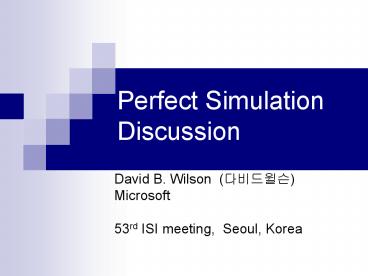Perfect Simulation Discussion PowerPoint PPT Presentation
1 / 25
Title: Perfect Simulation Discussion
1
Perfect Simulation Discussion
- David B. Wilson (?????)
- Microsoft
- 53rd ISI meeting, Seoul, Korea
2
Perfect Simulation Discussion
- David B. Wilson (??? ??)
- Microsoft
- 53rd ISI meeting, Seoul, Korea
3
How long to run the Markov chain?
- Convergence diagnostics
- Workhorse of MCMC
- Never sure of equilibration
- Mathematical analysis
- Sure of equilibration
- Have to be smart to get good bounds
- Perfect simulation
- Sure of equilibration
- Computer determines on its own how long to
run - Relies on special structure
- (Sometimes Markov chain not used)
4
Perfect Simulation Methods (partial list)
- Asmussen-Glynn-Thorisson 92
- Aldous 95
- Lovász-Winkler 95
- Coupling from the past (CFTP) Propp-Wilson 96
- (related ideas in Letac 86, Broder 89,
Aldous 90, Johnson 96) - Fills algorithm (FMMR)
- Fill 98, Fill-Machida-Murdoch-Rosenthal 00
- Cycle-popping, sink-popping
- Wilson 96, Propp-Wilson 98,
Cohn-Propp-Pemantle 01 - Dominated CFTP Kendall 98, Kendall-Møller 99
- Read-once CFTP Wilson 00
- Clan of ancestors Fernández-Ferrari-Garcia 00
- Randomness recycler (RR) Fill-Huber 00
5
Statistical Mechanics vs Statistics
- Many variables, homogenous and simple
interactions - Fewer models that get studied intensively
(universality) - ad hoc methods
- Focus on special points (phase transitions) where
mixing is slow
- More complicated interactions
- More different types of models
- General methods to mechanize study of new models
(e.g. BUGS) - Focus on generic points (real world data)
6
Perfect Simulation ? Mathematics
- Cycle popping algorithm used by Benjamini, Lyons,
Peres, Schramm to study uniform spanning
forests on Z and other graphs - CFTP used by Van den Berg Steif to show Ising
model on Z² above critical point has finitary
codings - CFTP used by Häggström, Jonasson, Lyons to show
that the Potts model on amenable graphs at any
temperature exhibits Bernoullicity
d
7
Coupling methods (partial list)
- Monotone coupling
- performance guarantee, efficient if the Markov
chain is - Antimonotone coupling
- Kendall 98, Häggström-Nelander 98
- Coupling for Markov random fields
- Häggström-Nelander 99, Huber 98
- Coupling for Bayesian inference
- Murdoch-Green 98, Green-Murdoch 99
- Slice sampling (auxillary variables)
- Mira-Møller-Roberts 01, Casella-Mengersen-Ro
bert-Titterington 0x - Simulated tempering (enlarges state space)
- (in context of perfect simulation)
Møller-Nicholls 0x
8
Random Tiling by Lozenges
- Perfect matchings on hexagonal lattice
- Diatomic molecules on surface
- Product formulas, circular boundary
- Monotone Markov chain
9
Coupling from the past (CFTP)
- Run Markov chain for very long (infinitely long)
time - Final state is random
- Figure out final state
10
Square-Ice model (physics)
- Boundary between blue white regions visit every
site once - Monotone Markov chain
(monotonicity not always apparent)
11
Autonormal model (statistics)Gaussian free field
(physics)
- Random height at each vertex, Guassian
distribution conditional on neighboring heights - Agricultural experiments
- Monotone Markov chain
- No top or bottom state
12
Ising model
- Spins on vertices
- Neighboring spins prefer to be aligned
- Models magnetism, certain forms of brass
- Two different monotone Markov chains (spin FK
representations)
13
Random independent set (CS)Hard-core model
(physics)
- Set of vertices on graph,
- no two adjacent
- Monotone on
- bipartite graphs
- Even odd sites
- shown in different colors
14
Potts model
- Generalizes Ising model to multiple spins
- Studied extensively in physics
- Image restoration
- Monotone Markov chain (FK representation)
15
Uniformly Random Spanning Tree
- Connected acyclic subgraph
- Generated via cycle-popping
- Also CFTP algorithm
- No monotonicity
16
Example from stochastic geometry
- Impenetrable spheres model
- Antimonotone coupling (Kendall,
Häggström-Nelander) - No top state
17
Fortuin-Kasteleyn (FK) model(random cluster
model)
- 13 edges
- 11 missing edges
- 5 connected components
Different qs give
- percolation
- Ising ferromagnet
- Potts model
18
Random Planar Maps
- Different embeddings of graph -gt different maps
- Enumerated by Tutte
- Linear time random generation by Schaeffer
19
FK model on random planar maps
- Annealed
- Pick planar map G and subgraph s together
Quenched First pick planar map G Then pick
subgraph s
20
Experimental values of quenched exponents
1/(?d) or 1/(2-a) 1/(?d) or 1/(2-a) 1/(?d) or 1/(2-a) ß/(?d) or ß/(2-a) ß/(?d) or ß/(2-a) ß/(?d) or ß/(2-a)
q2 q4 q10 q2 q4 q10
conjecture .3486 .5886 none .1452 .1452 none
Janke-Johnston .34 .42 .58 .10 .11 .12
Schaeffer-W (preliminary) .34 .38 .43 .135 .15 .17
21
Torpid mixing of Swendsen-Wang for large q
- Complete graph q 3
Gore-Jerrum - Grid graph q big
Borgs-Chayes-Frieze-Kim-Tetali-Vigoda-Vu
98 cancelation
22
- It is also noteworthy that the q10 measurements
(and also the q4 quenched theory predictions)
violate a supposedly general bound derived by
Chayes et al. 23 for quenched systems, ?Dgt2,
since ?D1.72 from the q10 measurements. - from Janke-Johnston
23
- Quenched exponent work still preliminary
- Many headaches associated with extracting
exponents - Many realizations of disorder, many
burn-ins - Torpid mixing / burn-in is one headache we dont
have
24
Chance favors the prepared mind. -Pasteur
- Most Markov chains do not have nice special
properties useful for perfect simulation - Special Markov chains more interesting than
typical Markov chains - Look for monotonicity or other features that can
be used for perfect simulation, sometimes one
gets lucky
25
Further Information
- http//dimacs.rutgers.edu/dbwilson/exact
- http//front.math.ucdavis.edu/math.PR
- perfect_at_list.research.microsoft.com

